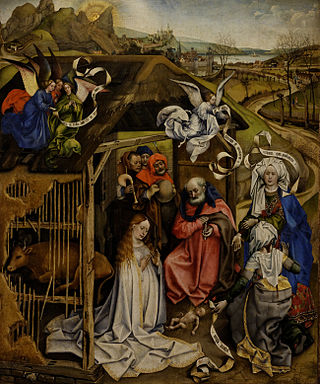Related Research Articles

The terms anno Domini (AD) and before Christ (BC) are used to label or number years in the Julian and Gregorian calendars. The term anno Domini is Medieval Latin and means 'in the year of the Lord', but is often presented using "our Lord" instead of "the Lord", taken from the full original phrase "anno Domini nostri Jesu Christi", which translates to 'in the year of our Lord Jesus Christ'. The form "BC" is specific to English and equivalent abbreviations are used in other languages: the Latin form is Ante Christum natum but is rarely seen.
The Julian calendar is a solar calendar of 365 days in every year with an additional leap day every fourth year. The Julian calendar is still used in parts of the Eastern Orthodox Church and in parts of Oriental Orthodoxy as well as by the Berbers, whereas the Gregorian calendar is used in most parts of the world.
AD 37 (XXXVII) was a common year starting on Tuesday of the Julian calendar. At the time, it was known as the Year of the Consulship of Proculus and Pontius. The denomination AD 37 for this year has been used since the early medieval period, when the Anno Domini calendar era became the prevalent method in Europe for naming years.
AD 25 (XXV) was a common year starting on Monday of the Julian calendar. At the time, it was known as the Year of the Consulship of Lentulus and Agrippa. The denomination AD 25 for this year has been used since the early medieval period, when the Anno Domini calendar era became the prevalent method in Europe for naming years.
AD 1 or 1 CE is the epoch year for the Anno Domini (AD) Christian calendar era, and the 1st year of the 1st century and 1st millennium of the Christian and Common Era (CE). It was a common year starting on Saturday or Sunday, a common year starting on Saturday by the proleptic Julian calendar, and a common year starting on Monday by the proleptic Gregorian calendar.

AD 23 (XXIII) was a common year starting on Friday of the Julian calendar. At the time, it was known as the Year of the Consulship of Pollio and Vetus. The denomination AD 23 for this year has been used since the early medieval period, when the Anno Domini calendar era became the prevalent method in Europe for naming years.
AD 33 (XXXIII) was a common year starting on Thursday of the Julian calendar. At the time, it was known in the Roman world as the Year of the Consulship of Ocella and Sulla. The denomination AD 33 for this year has been used since the early medieval period, when the Anno Domini calendar era became the prevalent method in the world for naming years.
Year 105 BC was a year of the pre-Julian Roman calendar. At the time it was known as the Year of the Consulship of Rufus and Maximus and the Sixth Year of Yuanfeng. The denomination 105 BC for this year has been used since the early medieval period, when the Anno Domini calendar era became the prevalent method in Europe for naming years.
Year 14 BC was either a common year starting on Thursday or Friday or a leap year starting on Wednesday, Thursday or Friday of the Julian calendar and a common year starting on Tuesday of the Proleptic Julian calendar. At the time, it was known as the Year of the Consulship of Crassus and Lentulus. The denomination 14 BC for this year has been used since the early medieval period, when the Anno Domini calendar era became the prevalent method in Europe for naming years.
Year 347 BC was a year of the pre-Julian Roman calendar. At the time it was known in Rome as the Year of the Consulship of Venno and Torquatus. The denomination 347 BC for this year has been used since the early medieval period, when the Anno Domini calendar era became the prevalent method in Europe for naming years.
In chronology and periodization, an epoch or reference epoch is an instant in time chosen as the origin of a particular calendar era. The "epoch" serves as a reference point from which time is measured.

Chronology is the science of arranging events in their order of occurrence in time. Consider, for example, the use of a timeline or sequence of events. It is also "the determination of the actual temporal sequence of past events".
Year 135 BC was a year of the pre-Julian Roman calendar. At the time it was known as the Year of the Consulship of Flaccus and Piso and the Sixth Year of Jianyuan. The denomination 135 BC for this year has been used since the early medieval period, when the Anno Domini calendar era became the prevalent method in Europe for naming years.
The history of calendars covers practices with ancient roots as people created and used various methods to keep track of days and larger divisions of time. Calendars commonly serve both cultural and practical purposes and are often connected to astronomy and agriculture.
A calendar era is the period of time elapsed since one epoch of a calendar and, if it exists, before the next one. For example, it is the year 2023 as per the Gregorian calendar, which numbers its years in the Western Christian era.
A chronology of Jesus aims to establish a timeline for the events of the life of Jesus. Scholars have correlated Jewish and Greco-Roman documents and astronomical calendars with the New Testament accounts to estimate dates for the major events in Jesus's life.

Anno Mundi, abbreviated as AM or A.M., or Year After Creation, is a calendar era based on the biblical accounts of the creation of the world and subsequent history. Two such calendar eras have seen notable use historically:

The ancient Roman units of measurement were primarily founded on the Hellenic system, which in turn was influenced by the Egyptian and the Mesopotamian system. The Roman units were comparatively consistent and well documented.
The Gregorian calendar is the calendar used in most parts of the world. It was introduced on February 24 with a papal bull, and went into effect in October 1582 by Pope Gregory XIII as a modification of, and replacement for, the Julian calendar. The principal change was to space leap years differently so as to make the average calendar year 365.2425 days long, more closely approximating the 365.2422-day 'tropical' or 'solar' year that is determined by the Earth's revolution around the Sun.

The date of birth of Jesus is not stated in the gospels or in any historical sources, but most biblical scholars generally accept a date of birth between 6 BC and 4 BC, the year in which King Herod died. The historical evidence is too incomplete to allow a definitive dating, but the year is estimated through three different approaches:
References
- ↑ Dzino, Danijel (January 21, 2010). Illyricum in Roman Politics, 229 BC-AD 68. Cambridge University Press. p. 180. ISBN 978-0-521-19419-8.
- ↑ Pollard, Elizabeth (2015). Worlds together, worlds apart. Clifford D. Rosenberg, Robert L. Tignor, Jeremy Adelman, Stephen Aron, Peter Brown, Benjamin A. Elman, Stephen Kotkin, Xinru Liu, Suzanne L. Marchand, Holly Pittman, Gyan Prakash, Brent D. Shaw, Michael Tsang-Woon Tsin. New York. p. 238. ISBN 978-0-393-93769-5. OCLC 890068060.